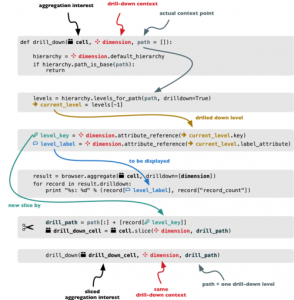In order for marketers to make important decisions within their careers, they must collect enough information to be able to do so. Whether marketers are most interested in improving the number of customers retained, how many customers engage with social media, or whether markets are penetrated or not, it’s crucial to analyze all sorts of data sets in order to understand how everything is interconnected.
 By dissecting data collection and how it is organized, marketers can better understand how to approach these needs. Understanding the Hierarchical Database Model and how data are organized into a tree-like structure can really lay the foundation for allowing marketers to recognize how data connections and patterns are intertwined.
By dissecting data collection and how it is organized, marketers can better understand how to approach these needs. Understanding the Hierarchical Database Model and how data are organized into a tree-like structure can really lay the foundation for allowing marketers to recognize how data connections and patterns are intertwined.
If, for example, a company decides to allocate more of a budget for advertisements, marketers must decide how the budget will be split, what kind of an audience will be targeted, and the content that should be put out into the public. Here is where the database model comes in and dimensions, measures, and hierarchies are put to use.

Dimensions
Dimensions are essentially their own categories of relevant information consisting of location, products, customers, time, and more. This information is “sliced” and stored as measured. There is a relationship between dimensions and measures due to the fact that each data entry in the measure has a value associating the entry with a set of descriptive information. Once all of this data is split into dimensions, companies can begin to better understand the information. It is essential for marketers to properly classify the categories and dimensions that are most needed depending on the project in order to have a firm grasp on insightful information.
Attributes
Attributes serve as a way to describe the dimension value because they provide characteristics of the specific value of the dimension. Each dimension contains an attribute. According to an article by Tongere Partners, “If you are a paint manufacturer and sell many types of blue pant with different subgroups, then it could be a node within your hierarchy. However, of blue is one of many colors in which your product is offered or one of the colors used on your product then it would be an attribute.” Attributes basically give marketers the ability to look across products independently of the hierarchy they belong to. Tongere Partners also gives an example of an apparel manufacturer wanting to know what color is trending across women’s and men’s clothes for tops and bottoms.
Hierarchies
A hierarchy differs from dimensions and attribute because it is a system where people and groups are ranked according to how important they are. Hierarchies establish order and structure information logically. Hierarchies are different from the actual items because items are assigned to a level within the hierarchy. You can think of this structure as a family tree in the way it is broken down. For example, the node becomes the family name and the elements below the node reference a family name. When hierarchies are organized, it becomes easier for marketers to understand how different dimensions and information are related.
It’s not always clearly understood how hierarchies and attributes should be structured but they are nevertheless crucial to data collection and marketing in general. There is a ton of data out there that lacks structure, and this is a clean way to strategize and define how data can be organized in order to benefit the business. When data is integrated with its hierarchies and attributes, companies benefit from valuable information that is often times necessary for a business’s growth.
